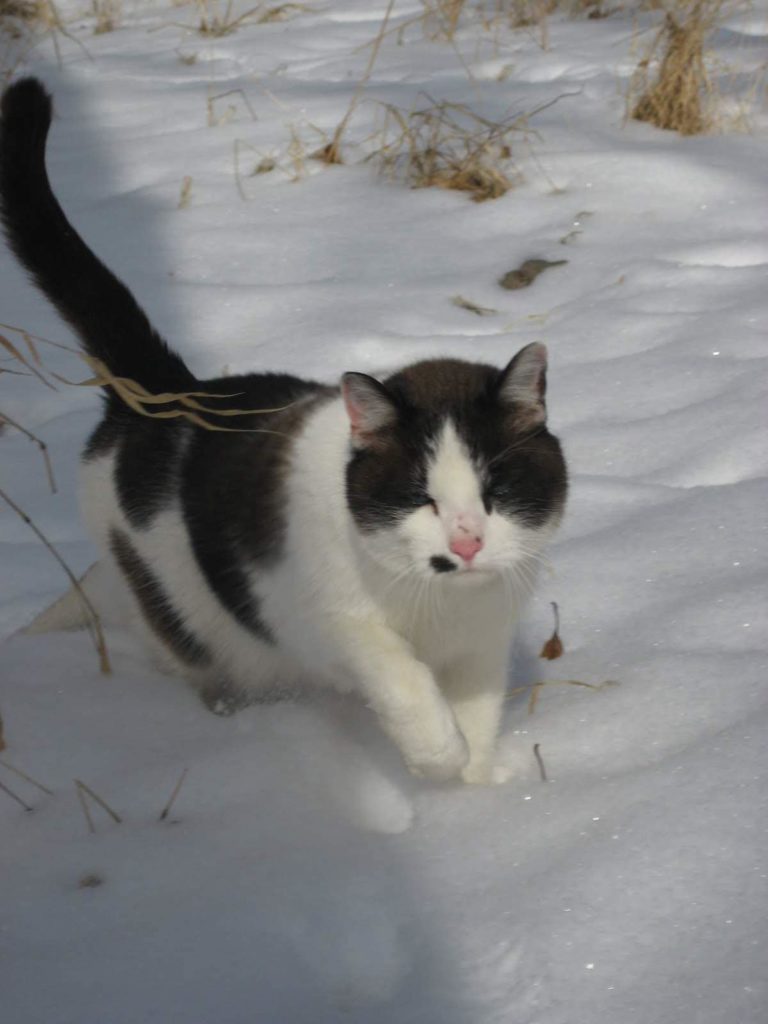By: Talin Seta Shahinian
The first and most important thing you can do to care for your cat in the wintertime is to keep them inside. Some cats tend to be escape artists and get outside despite your best efforts, but the goal you want to strive for is keeping them indoors. While indoors, make sure you keep them warm and toasty; make sure they have comfortable, warm spots to rest and nap away from any drafts. Provide cat beds, their favorite blankets, and cozy cat igloos, which are felt or fabric houses they can go into to keep warm.
Top 5 Cat Safety Winter Tips

- Stock Up. Make sure you’re stocked up with cat supplies. Here in Wisconsin, you can count on two things in the winter, bitter cold and a lot of snow! Keep your supplies of cat food, treats, and litter stocked up so that if a bad storm comes, you won’t be scrambling trying to feed your kitty or struggling to keep the litter box clean.
- Hydrate. Make sure your cats have plenty of fresh water. Keeping your kitty well hydrated is essential, as dehydration can occur from indoor dry heat. Additionally, if he sneaks out or gets into your garage, you want to make sure he isn’t tempted to drink any antifreeze spills. Cats are attracted to the taste of antifreeze, which is toxic for them. It’s also present in the solution you spray to melt ice off your windshield, and car door handles. Be careful to clean up any spills immediately, and make sure you close caps tightly on any stored bottles of antifreeze.
- Secure. Make sure the entrances and exits to your home are secure. If you let your cats go outside at other times of the year, and have a cat door installed, cover it securely. You also don’t want any critters seeking warmth to end up using it to come inside! Also, make sure you seal up any other spaces where animals could get into your home, such as an open chimney flue. You want to prevent injury to your cat, and wild animals can also transmit rabies.
- Practice fire safety. Cats love the warmth and will always seek it out. If you have a fireplace, your cat will be drawn to curling up nearby, so make sure your fireplace screen is secure. Cats also love to nap near space heaters, so only buy the type that has an automatic shut-off feature just in case a curious kitty tips it over. If you enjoy candles, keep them away from your cat, or better yet, use tea lights or any candle that can be placed inside an enclosed holder or used with a glass or metal cover.
- Veterinary Care. Keep up with your cat’s vet visits. Regular check-ups and routine wellness care are important for your cat’s year-round health. Likewise, continue to feed your cat the most nutritious food you can afford. Ask your vet for dietary recommendations if you’re unsure which cat food is best. Nutritious food promotes a full, healthy coat for insulation and helps her avoid common winter ailments, such as upper respiratory infections.
What Should I Do If My Cat Gets Out?
If despite your best efforts, your cat manages to dart out when you open a door, your best bet to be reunited with your cat is to make sure he’s microchipped. A cat may get disoriented and lost in the snow, so you want to track him and bring him back inside. First, walk the perimeter of your house, calling his name, as he may be eager to return after experiencing the cold. Try luring him back with food and water as well, but don’t leave it out too long, as it will end up freezing.
Cold Hazards and How to Treat Them
If your cat is stuck outside for a length of time, she may experience one of these cold-weather hazards:
Hypothermia
Another reason it’s vital to keep your cat indoors is the risk of Hypothermia. Especially in extreme cold, it can happen rapidly. The signs of moderate to severe hypothermia include:
- Difficulty breathing.
- Muscle stiffness.
- Mental stupor or confusion.
- Slow heartbeat.
- Low blood pressure.
- Dilated pupils.
- Coma (in extreme cases).
If your cat got outside and is showing any of these signs, warm her up as best as you can by wrapping her in a warmed towel and taking her to the vet immediately for treatment. You can also bring empty soda bottles and fill them with hot water to help keep your feline friend warm on the way to the vet clinic. Be sure to monitor the heat level not to burn the skin.
Frostbite
Another risk of prolonged cold exposure is frostbite, attacking her tender paws. Do not rub the affected area, as this can further damage the tissue. Get your cat to the vet immediately. If that’s not possible due to a storm, you can warm up her paws at home. Immerse the area in warm (not hot) water, or use warm, moist towels, changing them frequently. As soon as you notice the affected tissue becoming flushed, stop the warming procedure and gently dry the area. If available, cover with non-adhesive bandages. Follow up with your vet as soon as possible.
If you live in NW Wisconsin, Purple Cat Mobile Vet Clinic is here to help you keep your cat healthy and happy. We’re a high-quality, high-volume, low-cost spay/neuter clinic. We see cats exclusively. Find information for scheduling on our www.purplecatvet.com website. You can also check out our Facebook page for more helpful information on all things feline.
